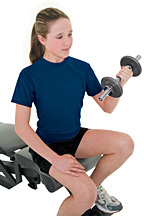The Right Way: So, what is a safer and more effective way of getting stronger without weight training? The answer is so simple, yet so effective and easy to do anywhere: body-weight training, which is a fundamental way to build stamina, strength, power and speed.
Examples of body-weight training include the basics: push-ups, sit-ups, pull-ups, squats, lunges and sprints.
Mistake #2: Ignoring Flexibility and Stability
The Wrong Way: Lack of proper stretching before and after physical exercise is a primary cause of unnecessary injury. Adults are even guilty of ignoring this important component of any exercise routine, but kids are even worse. The body must be properly warmed up and primed for maximum physical performance and recovery. Without proper blood flow and joint lubrication, the risk of injury is drastically increased. Too often, people who do stretch use static stretch-and-hold techniques; if they go beyond comfortable limits, this type of stretching can actually put the muscle at risk of tearing due to the body's inherent self-protective guarding mechanism.
 The Right Way: The most effective stretching techniques for athletes of any age are called myofascial release and active isolated stretching. These are the "secret weapons" of professional athletes looking to increase performance and reduce injury risk. While you may not have heard of these techniques by name, you've probably seen them in action at the gym or on fitness-oriented TV shows.
The Right Way: The most effective stretching techniques for athletes of any age are called myofascial release and active isolated stretching. These are the "secret weapons" of professional athletes looking to increase performance and reduce injury risk. While you may not have heard of these techniques by name, you've probably seen them in action at the gym or on fitness-oriented TV shows.
Myofascial release involves rolling muscles over a cylindrical foam tube to increase blood flow and tissue flexibility. Active stretching uses ropes or bands to elongate muscles and prevent over-lengthening and tearing. I have used this effective combination of massage and stretching for years with all of my athlete patients and cannot recommend it highly enough. Taking just five minutes before exercise or competition to perform these techniques may prevent a life-altering injury from occurring.
Mistake #3: Overtraining
The Wrong Way: The body grows and recovers with rest, not from exercise itself. In this fast-paced, on-the-go world, youngsters are always on the move, hardly taking a moment to rest. They go from one activity to the next and get increasingly less sleep and time for true relaxation. Add the stresses of intense exercise, and you push the body to the brink of breakdown.
Hard training breaks you down and makes you weaker. Rest makes you stronger. Physiologic improvement only occurs during the rest period following hard training. If sufficient rest is not included in a training program, regeneration cannot occur and performance plateaus. If this imbalance between excess training and inadequate rest persists, performance will decline. "Overtraining syndrome" is the name given to the collection of chronic (persisting for weeks, months or even longer) emotional, behavioral, and physical symptoms due to overtraining. Athletes know it as "burnout." Overtraining is marked by cumulative exhaustion that persists even after recovery periods, and makes the body more prone to injury.

